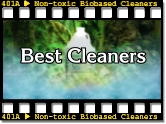
|
|
Services
–
What You Need and What You Can Expect Pro-active Environmental Technologies
to do for You –
|
Services
Services Overview -- Part 3 -- Treating the Problem and Preventing a Recurrence

Too
often, corrective actions, if any, are more likely to be cosmetic
than curative. The common mis perception is that wiping or washing
a mold covered or other infected area with some sort of bleach ingredient cleaner
will take care of the problem which can then be followed by a fresh coat of paint
in more extreme cases. In both instances the assumption seems to
be that if the color goes away the mold goes away. Somehow we believe that what
we cannot see cannot then exist. Unfortunately, such is not the
case.
In
reality, bleach may cause the ugly color of mold to go away, but
even strong household bleach products are usually insufficient to
even pierce the extremely hardy shell of the mold spore, much less
kill it or turn off its reproductive capabilities. The irony created
by adding paint is that we merely cover over the spores with a high
moisture, cellulose-rich product which cuts off the anaerobic fungi
from fresh air! When mold shows up again, which it inevitably must
under those circumstances, we cry, “It’s back!”
Truth is, it never really left. Real corrective action must be taken
to achieve satisfactory results.
Some of the
mold products are fairly environmentally safe. Others are
known to be quite toxic. Toxic or not, most will leave a residue
of some sort. Irrespective of their relative safety, whether the mold
killing ingredient is wiped on, sponged on, mopped on, sprayed on,
blown on, or applied in some other manner, in order to be
effective the agent must actually come into contact with the mold/mold
spores in sufficient quantity and with sufficient dwell time to soften
the shell, penetrate the cell, and deactivate or kill the mold or mold
spore. Any area of mold or cluster of mold spores not physically coming
into contact with the mold killing agent or product will not be
adversely affected and brought under control. To the extent that
such is the case, the potential for recurring outbreaks exists.
|
|
Unprotected worker, oblivious to his own and the building's
danger.
|
Once
the source of mold or microbial infection has been found
and the contributing causes addressed, it is time to
rid the structure of the accumulated problem. Especially
with mold, this must be done very cautiously, for carelessness
at this stage can not only fail to kill the existing
mold but can also fail to capture the disturbed mold
spores which are designed to rapidly disperse by the
billions upon any movement or commotion, spreading almost
instantaneously to other parts of the building. A mishap
at this point can be disastrous for all parties concerned. |
|
|
a. |
Discussions
below do not include other safety issues as to the treatment
of hazardous materials and removal procedures for construction
materials, furnishings, household items, personal effects,
or any other item/s or component/s tainted by or suspected
of being infected with mold and/or mold spores and/or
mold by-products and/or other pathogenic contaminants.
|
|
|
|
b. |
Neither
are specific protocols addressed regarding the dress
and breathing protection of workers or other personnel
who might at some point come into contact with mold
and/or mold spores and/or mold by-products or mold infected
materials and/or other pathogenic contaminants of any
type or sort. |
| CAUTION:
Exclusion of the areas of information
in any way related to the two previous enumerated sentences
above IN NO WAY implies, suggests, condones, or recommends
ANY contact with mold and/or mold or microbial infected
materials by any other than professionals trained and
practiced in the best and latest methodologies for protecting
themselves and others. The information following ONLY
deals with the actual mechanical or technical procedures
as set forth below — apart from personal safety
protections and concerns — as a way of familiarizing
the public with the options available should any type
of mold or microbial treatment be necessary. |
For
smoke and odor issues, the idea of filtering
enough air to clear it is almost laughable, yet, until
recently, that was all that was available. At best,
all that can be achieved with this method is diluting
the problem sufficiently that it becomes less noticeable
-- followed by or accompanied with the introduction
of a counter scent to offset the smell of the smoke
or offending odor.
For microbial infestations, until of late we have used
refined and/or synthesized chemicals which have given
rise to increasingly resistant strains of infections.
Mold
related drywall and other building repairs fall under
the classification of remediation.
"Remediation" is a word which encompasses everything
required to bring a structure and its indoor environment
back to the condition which existed before mold became
an issue. Obviously, the greater the extent of the
infestation and/or damage, the more remediative work
is required to return things to normal.
To
understand the efficacy and superiority of Mold and/or
Air Sanitization,
it is first necessary to be familiar with the strengths
and weaknesses of the conventional protocols.
|

|
|
a. |
Standard
(“Conventional”) Protocol -- Ox cart technologies
in a space age world.
|
 |
|
|
|
If
the only mode of transportation available were still
the ox cart, it would make sense to use it as often
as possible. But where newer, better, faster,
less cumbersome technologies exist and are easily and
economically obtained, it seems strange to hold onto
old methods and ways -- especially when the life and
health of vast populations are at stake, as they are
with indoor air quality issues. |

|
|
|
(1) |
The
Procedures
of Conventional Protocol are these.
Conventional
remediation protocol has existed since at least Older
Testament times, as evidenced in the book of Leviticus
14:33-48. Basically, conventional methods
had to do with identification of the problem, removal
of the occupants once the problem was diagnosed, removal
of the offending materials, replacing elements which
had been removed, checking/testing again for the effectiveness
of the repairs, and destruction of the whole building
if the problem persisted. Of course, we have added
some modern twists with the technology more recently
available, but otherwise there are great similarities
from ancient times to today.
While
as currently practiced and as set forth below, under
certain circumstances there may well be other steps
involved, but at no time should the order of chronology
of the items immediately presented ever be changed.
They
at all times include, among others —
|
|
|
|
|
(a) |
Immediately
upon recognition or confirmation of a mold problem and
BEFORE the commencement of any type of mold abatement
or remediation program — the
evacuation of any and all environs of any breathing
species from all areas connected by air space to the
affected area/s. In the event that an affected
area is in any type of multi-family or multi-unit structure,
consideration may well also include the evacuation of
all units physically connected with the affected unit.
At the very least, out of courtesy, if not release of
culpability, notification of what is happening should
be made to the other residents of the building as soon
as it becomes known. |
|
|
(b) |
Following evacuation comes the removal
of moisture/mold affected drywall and construction components
by proper industry-recognized procedures. |
|
|
|
|
(c)
(d) |
After
comes the proper cleansing
or purging of the exposed cavity areas with a
mold wash approved for the particular materials to be
cleansed.
Only
after items (a) - (c) above and any other related steps
- lastly comes the installation of new construction
materials, including, but not limited to, drywall or
plaster to meet the surrounding surfaces, and the taping,
finishing, texturing, and painting of the new drywall,
et al, to match the existing.
|
|
|
|
|
|
|
|
|
|
(2) |
The
Prerequisites
for Conventional Protocol are these.
Physical
and cosmetic issues are not all that need to be considered.
Before
any actual conventional treatment or remediation is
to be undertaken, standard protocol for dealing with
actual or suspected mold infected/infested areas must
include, at the very least –
|
|
|
|
|
(a) |
a properly constructed containment
area to be erected around the area/s slated for
remediation PRIOR TO
ANY DISTURBANCE OR REMOVAL OF AFFECTED MATERIALS.
|
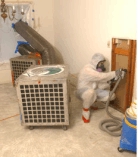 Regardless of the names given to them, "air scrubbers" are just glorified vacuum cleaners.
Regardless of the names given to them, "air scrubbers" are just glorified vacuum cleaners. |
(b) |
Immediately
after the erection of the containment area and PRIOR
TO ANY DISTURBANCE OR REMOVAL OF AFFECTED MATERIALS,
air “scrubbers”
or ventilation equipment must be temporarily installed
within the containment area/s.
|
| (c) |
Negative
air pressure must be established on the inside of the
containment area/s whereby a “vacuum”
or air deficiency is created within the contaminated
area/s which draws air from the theoretically non-contaminated
portions of the building into the affected area/s and
from there to the outside. |
|
|
|
|
(d) |
Closed
system ventilation from the containment area/s to the
exterior of the building must allow for contaminated
air to be exited outside of the living space and well
away from occupied spaces. Such ventilation may or may
not include some effort to filter out and contain the
mold spores from the contaminated air before expulsion
outside.
|

|
|
|
(3) |
The
PRO’s of this protocol are as follows. |
|
|
|
|
(a) |
It
is necessary so that any mold spores in the affected
areas are removed from their situs and expelled outside
the dwelling so that further mold contamination of non-mold
infested areas within the structure does not take place. |
|
|
|
|
(b) |
It
is necessary for the safety of the workers so that their
exposure to potential mold spores and subsequent infection
is minimized.
|
|
|
|
(4) |
The
CON’s of this protocol are based upon its inherent
limitations and flaws. |
|
|
|
|
(a) |
While
it conforms with standard protocol, it is yesterday’s
technology and does not represent the Best
Available Today’s Technology (BATT),
the higher technological, moral, and legal playing ground
one would wish to be on should litigation become an
issue. |
|
|
|
|
(b) |
While
it is designed to lessen the probability, it cannot
with surety preclude cross-contamination of the remaining
occupied spaces or other structurally connected areas. |
|
|
|
|
(c) |
It
does not provide the highest level of safety for the
workers. |
|
|
|
|
(d) |
Along
with being inferior, it does not necessarily represent
the most cost-effective option available. In fact, almost
without exception, it does not. |
|
|
b. |
Superior
Protocol --
Introduction to "BATT" (Best Available Today's Technology) --
For Mold, Odor, and Microbial Abatement. |
 |
|
|
|
The
standard remediation protocol of “seek and destroy”
which must remove anything at all affected with mold
(plus an additional safety margin of eighteen inches
of material beyond the furthest evidence of mold) is
necessary because mold and mold spores are extremely
hardy and resist conventional methodologies and products.
With so much demolition taking place, it is both time
and resource consuming.
For microbial infestations, the protocols have been
far less precise and effective. In fact, for pathogens,
the very chemicals employed to defeat them have actually
caused mutations which have made many of them either
resistant to or impervious to the products used to control
them. But until recently, no viable alternative
existed.
For smoke and odor abatement, as mentioned above, whatever
was not to some degree filtered or diluted usually has
wound up being covered up or masked by a stronger, hopefully
less offensive smell.
Thankfully, by closely examining the forces designed
in nature to do the job so well that life has been and
can continue to be sustained in the face of constant
use and pollution, the technology now exists which brings
into the indoor environment those same forces with similar
efficacy for all the IAQ issues we face. |
|
|
|
(1) |
Superior
to the above conventional protocol is a procedure called
“mold sanitization” or "air sanitization",
a proprietary process which uniquely duplicates indoors
the same processes designed and found in nature to kill
virtually all existing mold/microbes and kill/sterilize
most, if not all, mold spores. This combination of technologies
has proven to be as effective as or more than that of
the standard conventional mold remediation, takes far
less time, inconveniences (and displaces) for a much
shorter period (which alone can represent a substantial
savings), costs anywhere from the same to substantially
less than conventional remediation, and is accomplished
by the following. |
Up to 250,000 of these mold spores can fit on the
head of a pin.
|
|
|
|
|
(a) |
As
with the standard protocol, immediately upon recognition
or confirmation of a mold or microbial problem and BEFORE
the commencement of any mold sanitization, there should
be the removal of all
people, pets, and living plants from the affected/treatment
area/s. This has as much to do with their protecting
them from mold exposure as it does with having them
absent during the sanitization itself.
NOTE:
Should the living space to be treated be part
of a multi-family or multi-unit structure, adjacent
occupants should at least, out of courtesy, be told
what will be happening and what to expect. Usually,
unless there is a serious cross ventilation problem
between units (as in a very rare shared HVAC system),
there will not likely be a need for neighbors to be
vacated during the procedure. |
|
|
|
|
|
|
|
|
|
|
(b) |
All
room doors, closet doors, cupboard and cabinet doors,
and bureau drawers are opened and left ajar. Switch
plates and outlet covers are removed wherever possible
to create entrance openings into the wall cavities.
Paintings, pictures, and other wall coverings are best
removed and kept off the walls until the sanitization
procedure is completed. Ideally, beds are stripped,
curtains pulled back, pillows stood up, clutter removed,
and the entire occupied space made tidy. All ceiling
and other fans are turned on (backwards, if possible,
where the flow of air is caused to go UP around
the centers of the rooms and descends down around the
perimeters) and the HVAC or furnace is set between 70°
and 75° F. If there is a humidifier or humidistat,
it is set between 50% and 60% relative humidity. All
these things are done to facilitate maximum circulation
and penetration of and optimal conditions for the oxidizing
plasmas. |
|
|
|
|
|
|
|
|
|
|
(c) |
Simultaneously,
a patented process introduces a plasma of ions and multiple
friendly oxidizers into the living space. Any one of
these oxidizers is powerfully beneficial on its own,
but the effect of them together is unparalleled, even
to the point of being able to infiltrate behind wall
cavities to strip the very hardy outer shells off of
mold spores, fungi, and numerous other pathogens and
contaminants, either efficiently killing them or rendering
them very susceptible to destruction if any are still
viable after initial contact with the plasma. |
|
|
|
|
|
|
|
|
|
|
(d) |
Additional
technology generates a high level of naturally occurring
penetrating oxidation gases which attack the nuclei
of the now exposed cells, either fully killing the pathogenic
cell, or, as in the case of mold spores, affecting the
RNA and the DNA of the spores so that they cannot reproduce.
(While science cannot agree as to whether such a spore
is technically “dead” or alive, there is
agreement that neutered cells cannot proliferate and
create mold colonies.) |
|
|
|
(2) |
This
patented combination of pro-active technologies has
been shown in university
studies to have a kill rate from at least 99.9%
to as high as six log (99.9999%) of surface laden pathogens
within 10 - 12 hours (as high as 100% in the case of
tested viruses). It is also so effective at cleansing
the area of particulates – the tiny dust and skin
particles often revealed in direct sunlight which bear
germs, viruses, bacteria, etc., through the air and
into our lungs – that no private or governmental
agency has so far been successful in designing a protocol
to test
the air’s purity, since all existing protocols
measure the vitality of germs on the particles
in the air – missing with this process. |
|
|
|
|
|
|
|
|
(3) |
The
sanitization procedure is typically run for seventy-two
(72) hours but may run longer based upon the total volume
of air space and the estimated level of mold, pathogens,
or odors in the structure, giving every opportunity
for the maximum effectiveness of the oxidization of
all contaminants within the building’s envelope. |
|
|
|
|
|
|
|
|
(4) |
Once
the proprietary sanitization equipment has been shut
down and removed, any surfaces where the old mold colony/ies
may have been visibly present can be cleansed with an
effective non-toxic mold cleaning solution without risk
to the worker/s. Unless mold has structurally compromised
a construction member or it cannot be aesthetically
made whole by resurfacing/repainting, etc., constructive
replacement is seldom required. Cleanup is typically
effected by normal housekeeping procedures. Any other
specialty cleanup of the area is done when warranted,
usually with the aid of a HEPA rated commercial vacuum
cleaner. Because of the ionization which has occurred
during the sanitization process (where small particles
have become attracted to one another), even the tiniest
(>.003 microns) have
clumped together
and can at this point be effectively caught by a viable
HEPA filter. |
|
|
|
|
|
|
|
|
(5) |
Those
surfaces which can be repainted are covered with a mold-resistant
and stain-blocking primer and a mold controlling premium
interior/exterior paint (usually 100% acrylic or other
mold-resistant coating). The paint and primer should
also be non-toxic, fire-retardant, have zero VOC’s,
and carry at least a 10-year mold-free warranty. |
Your
swimming pool can teach you a lesson
about
the air you breathe. |
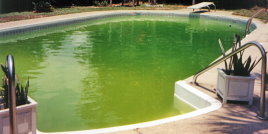 |
Like
swimming pools, which we expect to be pristine and clear,
our indoor air quality, especially in a closed system,
can go just as bad and be even worse. Unfortunately,
unlike the pool, the air does not turn color to let
us know that it has turned south on us and is hurting
our health.
As
with the pool, when the situation has gotten this bad,
routine maintenance or fixes will not make things good
again. |
| Mold
sanitization works similarly to "shocking" a swimming
pool. It raises the oxidizers in the air to a
level which effectively overwhelms the pathogens, microbes,
mold spores, and numerous viruses which have taken over
the air space and kills them and rids them from the
air we breathe. |
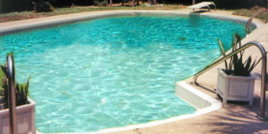 |
| As
with the pool, once the air has been effectively sanitized
("shocked"), a treatment system should be installed
to keep the air from ever turning on us again under
normal circumstances. These background active
air purifiers can also be selectively bumped up to a
"turbo" mode while we are away from the air space for
two to eight hours to give the air an extra cleansing
or purifying boost. |
|
E. |
Ongoing
Prevention and Indoor Air Quality Program
|
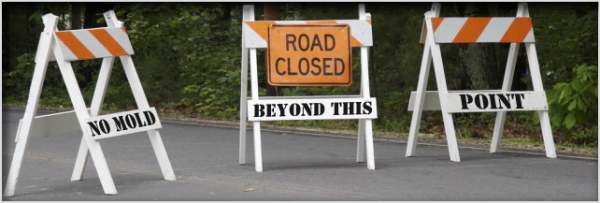 |
|
1. |
Following
the sanitization procedure, it is important to remember
that mold and other pathogenic growth can and does take
place if the following conditions exist — |
|
|
a. |
sufficient
relative moisture or humidity, |
|
|
|
b. |
favorable
temperature ranges, |
|
|
c. |
the
availability of food sources (found in virtually all
modern building materials), |
|
|
d. |
improper
or insufficient ventilation and air circulation, and |
|
|
e. |
the
continued presence of newly introduced viable mold spores
or microbes/viruses. |
|
2. |
Once
inside, those spores or pathogens would naturally breed
and proliferate if they can find four things – |
|
|
a. |
a
food supply (for mold and most pathogens, cellulose,
which is just about everything of which the interior
structure and the contents are comprised), |
|
|
b. |
temperatures
above 60 degrees F, |
|
|
c. |
moisture
in excess of about 50% relative humidity, and |
|
|
d. |
surfaces
without direct sunlight.
|
|
3. |
 Therefore,
it is reasonable to assume that, even after an initial
mold, microbial, or smoke problem has been sanitized,
there exists the potential for such a problem to come
back at another time, howbeit in not necessarily as
virulent a form. Therefore, proactive
steps need to be taken to prevent the recurrence of
such outbreaks and to assure safe indoor air quality
in the future. They employ the same technologies
as those used for sanitization but scaled back to a
preventative level. These pro-active steps include at
minimum the following. Therefore,
it is reasonable to assume that, even after an initial
mold, microbial, or smoke problem has been sanitized,
there exists the potential for such a problem to come
back at another time, howbeit in not necessarily as
virulent a form. Therefore, proactive
steps need to be taken to prevent the recurrence of
such outbreaks and to assure safe indoor air quality
in the future. They employ the same technologies
as those used for sanitization but scaled back to a
preventative level. These pro-active steps include at
minimum the following. |
|
|
a. |
Installed
in the plenum above the coils of each A/C unit should
be an indexed device which utilizes the RCI™ (“Radiant
Catalytic
Ionization™”) patented Technology.
The purpose of the device is to purify and sanitize
the interiors of the duct work system to prevent the
buildup and proliferation of unwanted pathogens, molds,
and fungi therein. It also helps tremendously
to control smoke and other odors.
|
|
|
b. |
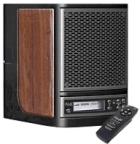 Depending
upon the total volume of air to be purified, at least
one portable device utilizing Radial Catalytic Ionization™
should be placed strategically within the occupied structure
as part of an ongoing air purification and sanitization
program. Used correctly and with sufficient air circulation,
the Space Certified™ patented technology of each
such a device can be adjusted or “tuned”
for the space/s covered to kill and eliminate a host
of airborne pathogens, contaminants, and odors. Depending
upon the total volume of air to be purified, at least
one portable device utilizing Radial Catalytic Ionization™
should be placed strategically within the occupied structure
as part of an ongoing air purification and sanitization
program. Used correctly and with sufficient air circulation,
the Space Certified™ patented technology of each
such a device can be adjusted or “tuned”
for the space/s covered to kill and eliminate a host
of airborne pathogens, contaminants, and odors. |
|
|
c. |
 Nature-based,
germ killing, odor reducing, smoke eliminating RCI™
air purification technology comes in a smaller version
for smaller spaces, quietly sending the active purification
solution to the pollution, killing germs on surfaces
that people touch and helping prevent the things people
worry about. Nature-based,
germ killing, odor reducing, smoke eliminating RCI™
air purification technology comes in a smaller version
for smaller spaces, quietly sending the active purification
solution to the pollution, killing germs on surfaces
that people touch and helping prevent the things people
worry about. |
|
4. |
 
Smaller RCI™ related appliances can be installed
in places like walk-in closets, water closets (they
make great room deodorizers), and upper attic spaces
to similarly protect and purify those spaces where air
circulation is not as efficient as in other parts of
the structure. |
|
5. |
Specifics
regarding these and other similar devices are to be
found elsewhere on this website under solutions.
Check with your Pro-active Environmental Technologies
IAQ specialist to determine the choice and placement
of the solutions you need to achieve the optimum indoor
air quality you and your loved ones need and deserve.
|
|
The
welcome and necessary addition of low
voltage, low maintenance RCI™ equipment will
not only achieve and keep the interior air as the "purest
air on the planet", but it will also prevent any new
mold spores, microbials, or other regularly introduced
pollutants (such as smoke) from outside from being able
to accumulate and reproduce, thus stopping any problem
before it becomes one.
Along with the remarkable results achieved in the university
studies, these units have also been shown to virtually
eliminate the indoor odor and ill effects of Red Tide
and other fungal blooms. |


All materials not supplied by manufacturers or others are
Copyright
2005 - 2014 -- breathe-easier
-- All Rights Reserved
|
 |
NEW!

Check
out the videos


A. The
Need for IAQ Services
It's a much-needed checkup for your building and the air you are breathing.


1. The Need for Mold Services
There's more than the appearance or lack of visible mold at stake. It could be your health and life!
go>>


2. The Need for General and Specific IAQ Evaluation Services
What you are breathing is either helping you stay healthy or making you sick.
go>>


B. Diagnostics -- Getting to the Source and Extent of the Problem
go>>


1. Visual
Mold Inspection
Start with the obvious. If you can see it, it must be taken away.


2. Surface Sampling
Not every discoloration is mold. Better know the difference. Can you tell?

3. Air Sampling
It's what you can't see in the air but are still breathing that can be the most harmful. Here's how to check it out.

a. Active
vs. Passive Air Sampling
Two ways to find out what's in the air and which is best.


(1) Passive
Air Sampling
Waiting for the contaminates to decide to hit the target on their own. Nice when it works, but how often is that?


(2) Active
Air Sampling
It's about going after what is in the air so you really know what you are dealing with.


b. Two
Types of Active Air Samplers
Specific ways to target specific contaminates.


(1) Total
Particulates
Getting a count of everything that wants to go into your airways.


(2) Viable
Colony Count
Besides being just downright obnoxious, how likely is what you are breathing going to cause an infestation or an infection?


4. Minimally
Invasive Boroscope® Inspection
This is a chance to see what is going on inside wall cavities and other out-of-sight places.


5. Moisture
Detection
Mold and pathogens, like us, need moisture. Are we giving them an opportunity to thrive?



C. Correctives
Knowing what is wrong is only part of the battle. Now let's explore our options for fixing the problem.


D. Abatement
When we talk about getting rid of mold, what are we really talking about?


1. Notice.
Venture into the Mold Zone only with extreme care and protective measures.


2. The
Options
Is there only one way to proceed, and if there are alternatives, what are they and how effective can they be?


a. Standard
("Conventional") Protocol
-- Ox cart technology in a space age world.


(1) The
Procedures of Conventional Protocol
If we are going to use yesterday's technology, let's at least do it the right way.


(2) The
Prerequisites for Conventional Protocol
There are certain things that must be done FIRST before going after mold in the conventional way.


b. Superior
Protocol --
Introduction to "BATT" (Best Available Today's Technology) -- For Mold, Odor, and Microbial Abatement.


E. Mold
Prevention and Indoor Air Quality Programs
It's one thing to get rid of an existing problem, but do we want a repeat appearance?
|
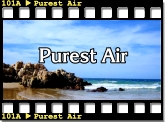





































































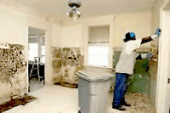
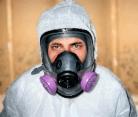


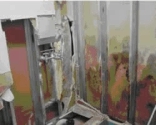
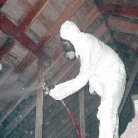

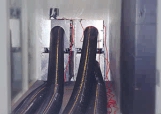

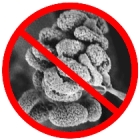



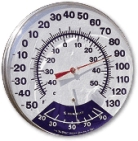
 Therefore,
it is reasonable to assume that, even after an initial
mold, microbial, or smoke problem has been sanitized,
there exists the potential for such a problem to come
back at another time, howbeit in not necessarily as
virulent a form. Therefore,
Therefore,
it is reasonable to assume that, even after an initial
mold, microbial, or smoke problem has been sanitized,
there exists the potential for such a problem to come
back at another time, howbeit in not necessarily as
virulent a form. Therefore, 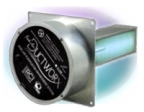
 Depending
upon the total volume of air to be purified, at least
one portable device utilizing Radial Catalytic Ionization™
should be placed strategically within the occupied structure
as part of an ongoing air purification and sanitization
program. Used correctly and with sufficient air circulation,
the Space Certified™ patented technology of each
such a device can be adjusted or “tuned”
for the space/s covered to kill and eliminate a host
of airborne pathogens, contaminants, and odors.
Depending
upon the total volume of air to be purified, at least
one portable device utilizing Radial Catalytic Ionization™
should be placed strategically within the occupied structure
as part of an ongoing air purification and sanitization
program. Used correctly and with sufficient air circulation,
the Space Certified™ patented technology of each
such a device can be adjusted or “tuned”
for the space/s covered to kill and eliminate a host
of airborne pathogens, contaminants, and odors. Nature-based,
germ killing, odor reducing, smoke eliminating RCI™
air purification technology comes in a smaller version
for smaller spaces, quietly sending the active purification
solution to the pollution, killing germs on surfaces
that people touch and helping prevent the things people
worry about.
Nature-based,
germ killing, odor reducing, smoke eliminating RCI™
air purification technology comes in a smaller version
for smaller spaces, quietly sending the active purification
solution to the pollution, killing germs on surfaces
that people touch and helping prevent the things people
worry about.




